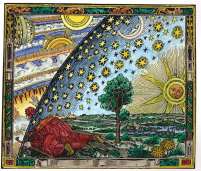The seasoned wisdom of thousands of years has gone into the makings of the I-Ching. Both branches of Chinese philosophy
- Confucianism and Taoism have their common roots in this ancient calssic, known also as The Book of Changes. The I-Ching
alone, among all the Confucian Classics, escaped the great burning of the books under emperor Chin Shih Huang Ti in 213 BC.
The origins of the I Ching go back to mythical antiquity, as a book of divination and as a book of wisdom. All that is
great and significant in Chinese cultural history takes inspiration fromt he I-Ching - aspects of the many related principles
and symbols of the Chinese predictive sciences, its view of the Trinity, Heaven, Earth and Man, the concepts of Yin and Yang,
balance and harmony, positive and negative forces, good fortune and misfortune, are all derived from interpretations of the
texts and judgements of the I Ching's 64 hexagrams.
The I Ching's Hexagrams are each made up of six lines, one placed above the other. These lines may be either broken
(--) or unbroken (-). Broken lines are known as yin and unbroken ones yang. These lines may also be changing or
unchanging (ie a broken yin line can change to an unbroken yang line and vice versa). Thus the key to understanding the texts
of the I Ching lies in the understanding of the placement of thse broken and unbroken lines in relation to each other.
The Hexagrams originated from three lined Trigrams (ie by doubling the Trigrams). There are 8 possible combinations of
broken and unbroken lines when arranged in sets of three lines. There are thus 64 hexagrams (8 X 8 = 64) . When placed in
sets of six lines, there are altogether 64 possible combinations of broken and unbroken lines. Each of the eight Trigrams
symbolize different meanings; and their positionings contain suggestions of good or bad luck. This aspect of the I Ching's
texts is what has made it China's premier classic on Divinations.
The I Ching's hexagrams contain symbols and ideas from nature, society and the individual. For those who consult the I
Ching before deciding on some action, the hexagrams offer wisdom, warnings, and also specific predictions of outcomes thereby
giving guidance on whether to proceed, wait or not to proceed at all. The hexagrams also advise on timing and behaviours and
attitudes directly related to the specific question asked. Where applicable, it counsels further preparation, or advocates
patience and even reveals misfortunes hidden in apparent good fortune and vice versa. Favourable or unfavourable conditions
are described, and difficulties, whether at the beginning or at the end are revealed.
The six lines of the hexagrams contain 3 elements - a symbol, an event and a judgement. The hexagram itself represents
overall indication of good fortune or misfortune. Interpretations of these elements are directly related to the question being
asked. Thus, in consulting the I Ching, questions must be specific.
Each hexagram contains four trigrams. These Trigrams each have an attribute, a symbol and a characteristic and are also
related to the five elements - water, wood, fire, metal or earth. The anatomy of every hexagram is made of two primary trigrams
and two nuclear trigrams.
The two primary trigrams consist of the top three lines and bottom three lines. The two nuclear trigrams are made up of
lines two, three and four (from the bottom) and lines three, four and five (from the bottom). The primary trigrams reveal
the circumstances of the situation being consulted, while the nuclear trigrams reveal the prediction. The latter
provide precise details for judging the nuances of predicted good or bad fortune. When consulting the I Ching, therefore,
readers must familiarize themselves with the meanings of each of the eight Trigrams as well as what they each symbolize. The
I Ching's texts on the 64 hexagrams may then be more fully understood, and predictions become clearer and easier to understand.

